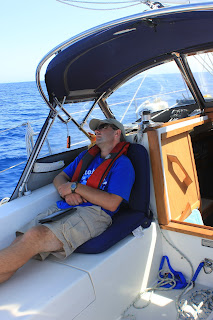10-1-12
– Somewhere between Santa Cruz Island and Santa Barbara Island – Day 91
I
figure it may get old just hearing about where we are and what we are doing day
to day. Yes we are constantly moving on
to new locations and you can usually see where we are by checking the SPOT. (If I remember to turn it on) So what is it that we really do day to
day? It’s been 91days since we moved
onto the boat and we’ve traveled about 900 miles to date. So what else have we been doing?
There
are sort of three different standard days.
Day one is a travel day. Day two
is a day at anchor. (This day could be
broken down into the subcategories of anchored with city access and anchored
with no city access) Day three is a day
at a marina; this being very similar to anchored with city access.
Travel
days usually begin earlier than all the rest.
Basically, figure out how far you need to go and then figure out how
long that would take you at a brisk walk/jog.
Then figure out when you need to leave in order to arrive at your
destination about an hour before dark to allow for anchoring etc.. Then there are the generalizations about
weather to consider, like you shouldn’t round Pt. Conception much after noon as
the wind comes up or usually the wind gets heavier in the afternoon. For a simple example figure we need to go 50
miles one day. That should take us
between 8.5 and 12 hours. It’s nice to
be at your destination at about 6:00PM this time of year. So that means we would leave somewhere
between 7:00 and 8:00 AM. Before
departure you need to have a morning workout of raising 35 lbs of steel and 50
feet of 3/8” chain off the bottom of the ocean, make some coffee, lunch for
later, eat breakfast and listen to the weather.
The do a final check of everything, and I mean everything, in the boat to make sure it will not move if shaken
vigorously and tipped at a 35 degree angle for extended periods of time. This does help to keep the counters and tables clean as nothing will stay there long if forgotten. Once the anchor is up and we have departed all that’s left to do is get to your destination. You now have 8 to 10 hours to kill. Books, charts and the local cruising guide works well to kill time.
 |
| Looking for billion ton freighters |
 |
| Always time for a nap. |
Today for instance we encountered about a dozen mylar happy birthday balloons floating in about a mile radius 20 miles offshore. After giving a couple of them a wide berth thinking they might be a fishing net we realized our folly and stopped worrying about them. You never know what you’ll see. Now all of this assumes that it is a nice day, not dark, not nighttime, not foggy. When those things are included in the equation everything seems to take on a higher importance. Now you must look intently into the fog as if you can see something, then down at the radar, hoping you see something there before you do in real life; then repeat endlessly. If you do see something on the radar and determine it is a boat then you need to hail them and make sure they see you also and then make sure you don’t hit each other. These situations can be stressful. Once at your destination you either drop the anchor, yes the one you picked up earlier that morning, or tie up to a dock.
 |
| Anchor Downs in the cockpit |
This is when the Anchor Down comes into play. It is a very important part of your day, used primarily to make sure your anchor doesn’t move once set, but sometimes employed even at a dock.
So
that basically encompasses the day of a vessel in transit. Wake up and lift the anchor. Move the boat via some propulsion method to
the next location. Drop the anchor. Feed yourself somewhere in there and try not
to get run over by things bigger than you.
It’s pretty straight forward in the end.
That may be why it is so rewarding.
You know for certain if you were successful or not at the end of the
day! I’m happy to say that we have been
very successful to date; although those whales did get pretty close today…
Days
at anchor and days at dock to come in the future. |
| Moon rise (yes, moon rise) |





It seems the old adage "The worst day on a boat is still better than the best day at work." still applies. I want to feel bad for you that there is so much boring time to kill, but I can't overcome the feeling that you are living your dream.
ReplyDeleteHope all is well - Happy Birthday to Elizabeth - look forward to talking with you soon.
Plautz -- Love the blog and look forward to reading about more of your adventures, they are way more interesting than the "where is Eigeneman" game. I especially like the picture of you pretending to be back at work moving dirt, hopefully it is the only time that you have thought of work. Hope all is well and keep the wet side down.
ReplyDeleteCates